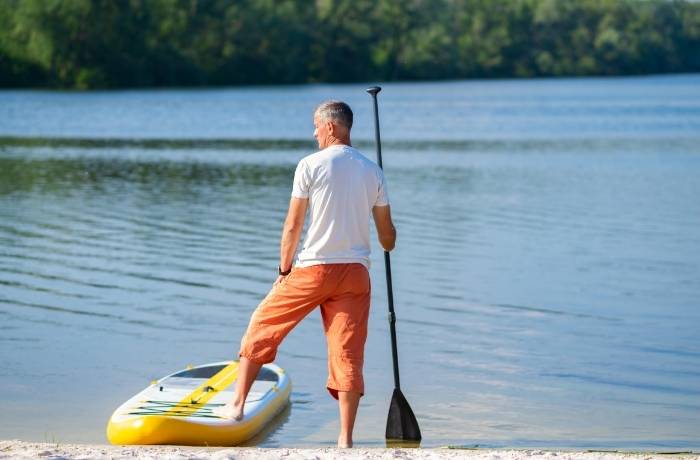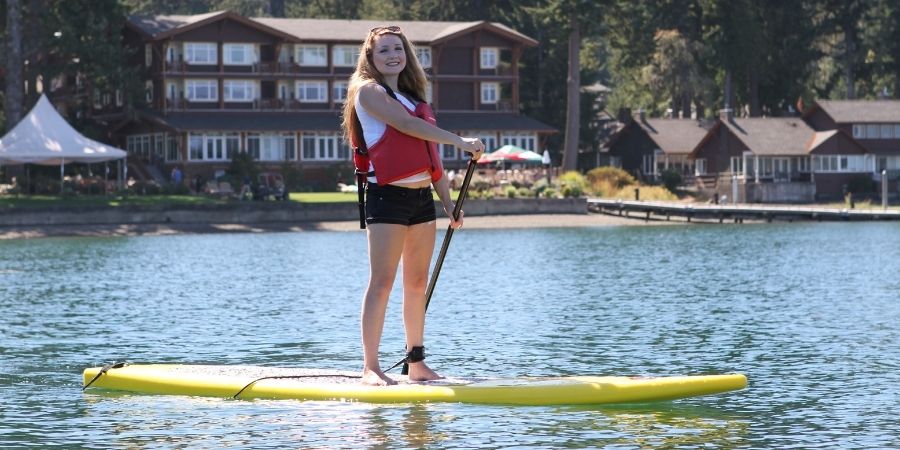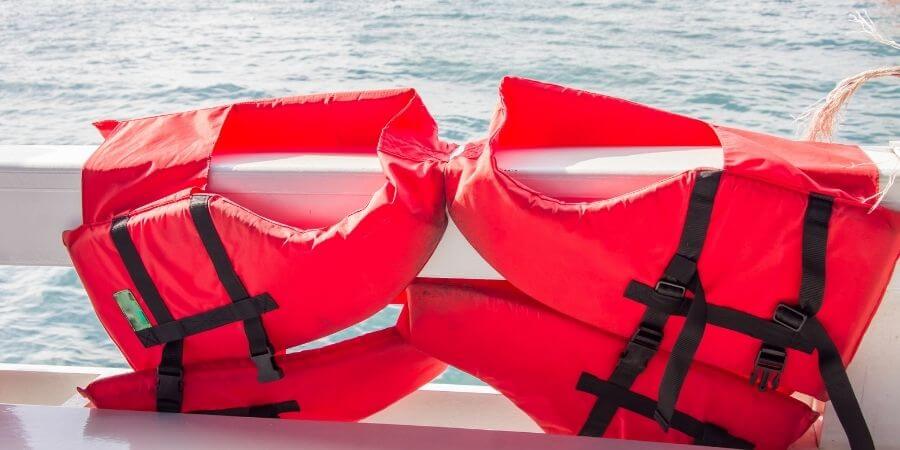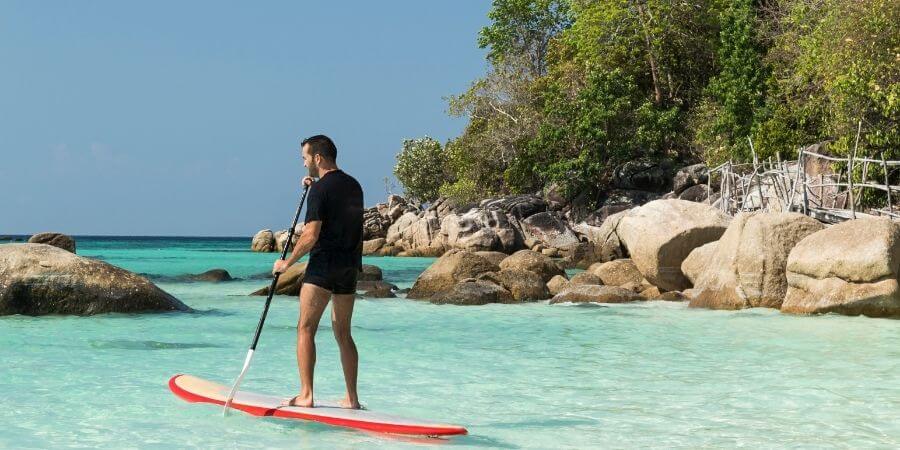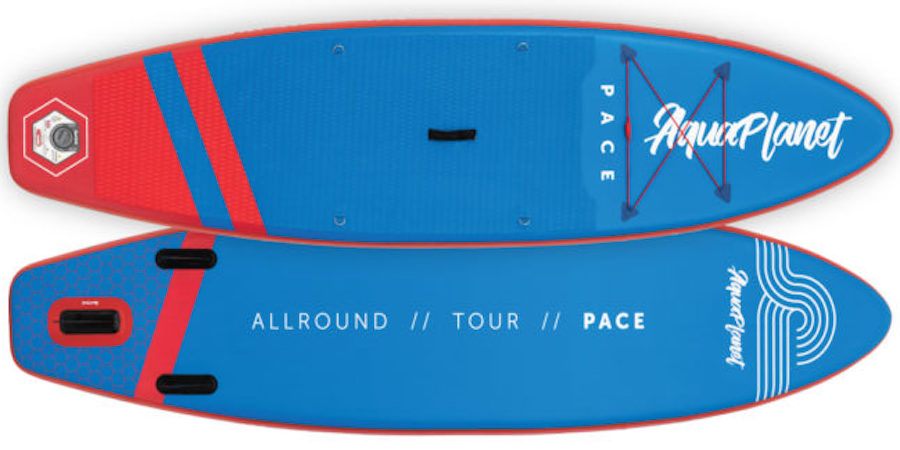SUP is an accessible and exhilarating sport. However, you should learn what to wear paddle boarding. You don’t need to spend a lot of money on this, but you have to stay comfortable and safe.
In this guide, we’ll teach you how to choose the right equipment and accessories. We’ll break these down according to weather, season, and activities.
Read on.
Table of Contents
Should You Wear A Life Jacket While Paddle Boarding?
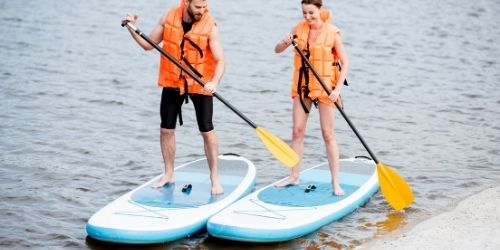
Yes, you should. Don’t forget your foot leash, either!
Make sure your life jacket is CE / EN marked. This marking ensures your jacket is safe for commercial and leisure purposes.
Warning: Don’t take off your life jacket during your ride.
If you’re surfing on your SUP board, your life jacket might feel too bulky. Luckily, you can browse an array of sleek life jackets with comfortable waist buckles.
Summer Paddle Boarding Wear
If you’re like most people, you love riding your SUP in the summer. The water is warmer, and there’s no chilly wind to give you goosebumps.
Most people go paddle boarding without any shoes in the summer because it’s easier to feel the SUP that way. Besides, you’ll have fewer layers of clothes, such as shorts and a T-shirt.
Unless you’re going on more extended tours.
In this case, you should have some layers or pack some clothes on the SUP. Consider a waterproof bag to pack your layers safely when you want to go swimming too.
The clothes you choose should be quick-dry and 50+ UPF to avoid sunburns. If there’s a slight breeze, you may not realise that the sun is heating your skin. So, use plenty of sunscreen.
Pro tip: Don’t forget to add a cap that protects you against insolation. Sunglasses keep your eyes safe from the water’s glare.
Spring/Autumn Equipment
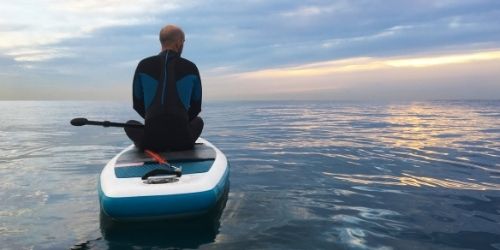
When it’s colder outside, you need to consider extra layers to keep you warm. For example, you’ll need a waterproof jacket, wetsuit, or long-sleeved shirt, depending on how warm it is.
Some people also wear neoprene boots when paddle boarding in colder weather. These boots are flexible but also waterproof. Thus, they allow you to move freely while keeping your feet toasty and dry.
Remember: Layer-up according to your needs, but choose light and waterproof items. Some people withstand cold temperature better than others. However, consider temperature-regulating clothes.
Another thing to consider is UV light.
These damaging sunrays don’t merely disappear in spring or autumn. Besides, water reflects them, so you’re more prone to getting sunburns on your SUP than on the shore. That means you still need a high-SPF SUP-wear.
Wetsuits are a common choice among paddle boarders because they’re warm and waterproof. These suits are insulating because they hem in a thin film of water inside. As your body heats it, you’re staying warmer for longer.
Pro tip: Choose a fitting wetsuit because it’s snug and comfortable. Besides, loose ones are less insulating.
Don’t forget your neoprene gloves, either. As a rule of thumb, spring and autumn neoprene clothes should be 3 or 4 mm thick.
Winter Equipment
Your winter paddle boarding equipment depends on your purpose. For example, if you’re surfing, you need to wear full-length neoprene wetsuits. You’ll also need boots and gloves to keep your extremities dry and warm.
Here’s what we recommend:
For around 0-5ᵒC:
- 4-5 mm thick wetsuit
- 5-mm thick footwear and gloves
For below 0ᵒC:
- 5-6 mm-thick wetsuit
- 7-mm-thick boots and gloves
If you’re not doing splash-provoking activities on your SUP, you may stay warm and dry enough without a wetsuit. For instance, if you’re doing a recreational tour or fishing, you need:
Thermal underwear
- Moisture-wicking shirt and leggings/ Long Johns
- Warm hoodie
- Waterproof jacket
- Waterproof pants
Pro tip: The more you exercise on your SUP, the warmer you’ll get. Don’t wear too many layers or thick clothing. Aim for insulating, waterproof, and moisture-wicking materials. The best quality SUP wear is lightweight and doesn’t restrict your range of motion.
Most winter wetsuits have hoods. If yours doesn’t, or you don’t want to invest in a wetsuit, don’t forget wearing a hat.
Sunglasses are also useful because glare isn’t going anywhere, even in the winter.
Alternative: Drysuits are a worthwhile alternative to wetsuits, especially in frigid weather and for static activities. Drysuits cage in a layer of air to protect you from cold weather, but they’re more rigid and expensive.
What Shoes To Wear Paddle Boarding?

Obviously, you can’t paddle board barefoot when it’s too cold outside. Coldwater is extremely dangerous because it causes frost bites and decreases your core body temperature.
That’s why you need light, waterproof shoes.
However, paddle boards are designed for barefoot use because you want to feel the SUP beneath you. A full grip allows you to keep your balance more effectively, avoid obstacles, and gain more speed.
You can solve this problem by purchasing flexible footwear that allows a full range of motion. That’s why most paddle boarders use barefoot trainers and neoprene boots in colder weather.
Pro tip: Avoid grippy outdoor shoes, even if they have better traction on wet terrain. However, if a stone gets stuck inside, it can ruin your SUP.
Also, avoid heavy shoes. These shoes are less flexible so that you won’t ride your SUP as quickly. Besides, they can cause muscle cramps and foot fatigue.
Things get even trickier if you fall off your paddle board and need to swim back.
Here are other shoes to consider:
Water sports shoes are best if you’re swimming because they’re quick-to-dry and airy. As such, they won’t become too heavy on your feet after some diving. Best quality water sport shoes are also flexible and help you keep your balance.
Aqua socks are snug but thin. They’re a good option for surfing in the summer, especially if you have pre-existing foot pain. Remember to choose a pair of tight aqua socks. Otherwise, they can make you lose your balance.
Glove shoes offer increased grip and flexibility because they sport individual compartments for each toe. As such, they promote more freedom of movement too.
Water sandals are a good alternative for tranquil waters because they’re not as snug as the options above. To protect your feet from injuries, choose grippy water sandals.
Deck shoes aren’t waterproof, but they’re ventilated and cushiony. As such, they’re best for fishing or relaxing on your paddle board. Their most significant advantage is their excellent traction on wet surfaces – and that’s why they’re called “deck” shoes.
SUP Yoga Equipment
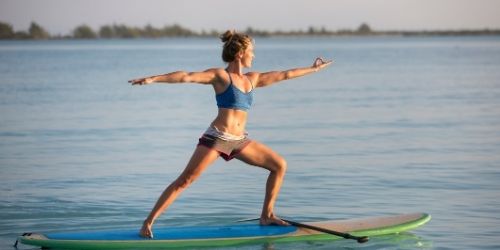
Sup Yoga clothes should be flexible and comfy. Adapt your usual Yoga equipment to the environment, so get waterproof, insulating equipment that protects against sunburns.
If it’s summer, bikinis or bathing suits are excellent choices. If the weather is colder, consider a rash guard. These long-sleeved shirts are insulating, flexible, and protect your skin from chaffing. Match your rash guard with a pair of water-resistant leggings or board shorts, and you’re good to go.
Pro tip: Try a few yoga poses dresses in your equipment before leaving the shore.
SUP Fishing Equipment
A lot of people like to do some fishing when they’re out paddle boarding. Luckily, it’s easy to dress for SUP fishing:
You’re just wearing regular boat-fishing clothes, adapted to the weather.
That’s because you’re not getting really wet unless you’re also doing some surfing afterwards.
Other equipment to consider is:
- Waders or neoprene boots
- Fishing vest
- Fishing gloves
- Waist-belt PFD
- Wide-brimmed hat
- Sunglasses
- Sunscreen
Pro tip: Don’t forget your SUP anchor!
Whitewater And River Paddle Boarding
Do you love paddle boarding on turbulent rivers? You need to wear the right equipment, which starts with an essential water jacket and helmet.
Chances are you’re going to fall at least once, even if you’re an expert.
Besides, river water is colder, so you need to get the best wetsuit. Don’t forget about protecting your toes, so choose grippy neoprene footwear. Rough waters are home to lots of hidden rocks that can injure your feet severely.
In Conclusion
After reading this guide, you have a better idea of what to wear when paddle boarding. Remember to choose flexible and protective equipment according to the weather and your activities.
Your clothes should keep you dry and warm but also offer full freedom of movement. If you need footwear, don’t wear your usual shoes because they’re not as protective.

